11+ SAMPLE Death Investigation Report
-
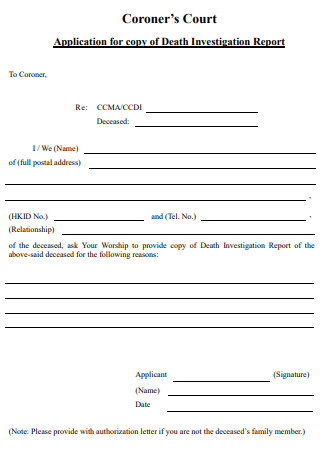
Copy of Death Investigation Report
download now -
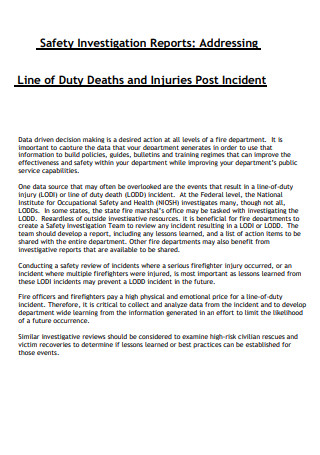
Duty Death Investigation Report
download now -
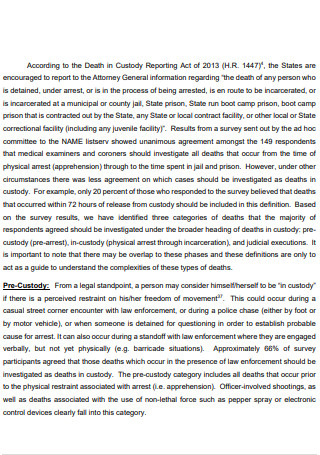
Sample Death Investigation Report
download now -
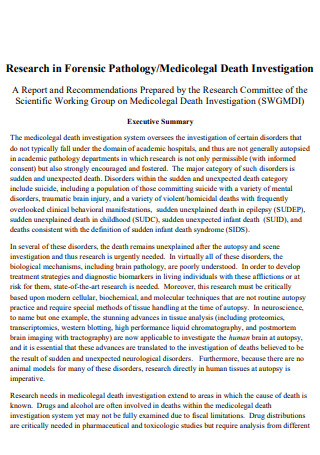
Medicolegal Death Investigation Report
download now -
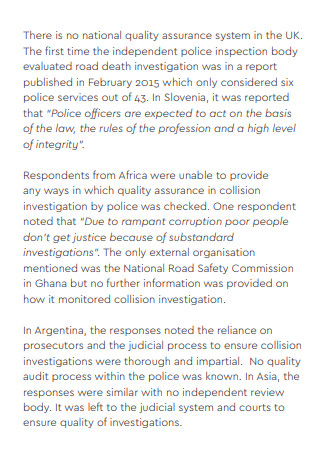
Road Death Investigation Survey Report
download now -
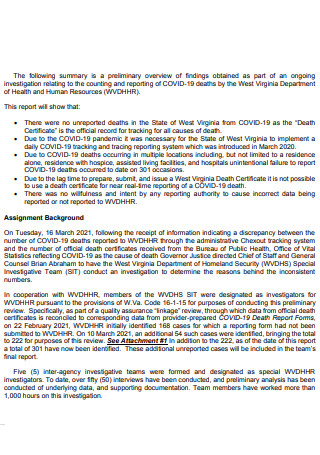
Covid 19 Death Special Investigation Report
download now -
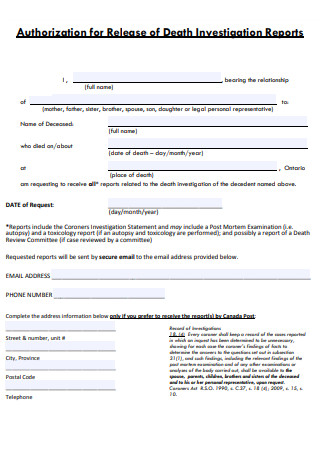
Authorization for Release of Death Investigation Report
download now -
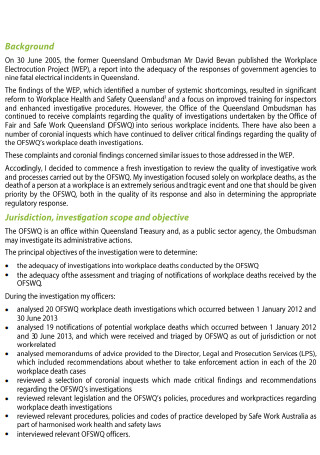
Workplace Death Investigation Report
download now -
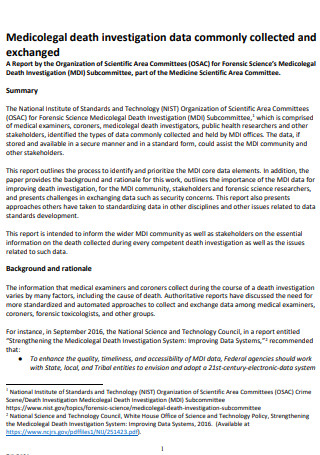
Death Investigation Report Example
download now -
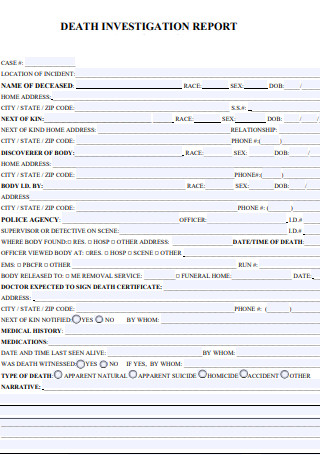
Formal Death Investigation Report
download now -
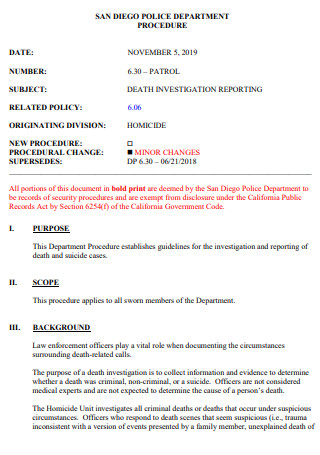
Basic Death Investigation Report
download now -
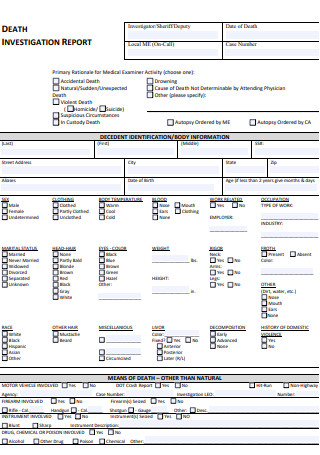
Death Investigation Report Template
download now
FREE Death Investigation Report s to Download
11+ SAMPLE Death Investigation Report
a Death Investigation Report?
Benefits of Conducting an Investigation Report
Types of Death
How To Conduct a Crime Scene Investigation
FAQs
Why write an investigation report?
What occurs during a homicide investigation?
Who bears the cost of an autopsy?
What Is a Death Investigation Report?
After a comprehensive inspection usually performed by a medical examiner, pathologist, or coroner, the findings are presented in a Death Investigation Report. This is a synopsis of the facts and circumstances underlying the death of a person. If the cause of death is judged suspicious, the report may move to a homicide investigation report, including biographical data and references to other investigative agencies, including law enforcement. Because this is such a delicate subject, death investigation reports must be thoroughly drafted based on the evidence supplied. Medical examiners and coroners investigate around 20% of the 2.4 million fatalities in the United States each year, accounting for approximately 450,000 medicolegal death investigations.
Benefits of Conducting an Investigation Report
There are numerous advantages to a successful investigation. Whether as the primary investigator or in collaboration with an investigator, your time and effort can benefit your business for various reasons.
Types of Death
Are you aware of the four types of death? A forensic pathologist will frequently conduct an autopsy during a death investigation. Throughout this procedure, the expert will examine the effect of damage, medicinal treatment plan, and diseases on the human body and then decide the way of death in court. The following are some fundamental facts concerning each type of death.
Natural Death
Natural death occurs as a result of a sickness or an internal malfunction caused by advanced age. This is especially true when elderly persons have various illnesses and ailments, none of which result in death when combined or alone, and it is unknown which condition causes mortality. For example, a person who dies due to a heart attack, abrupt heart failure, or influenza has died naturally. Most health departments oppose identifying old age as a cause of death since it serves neither medical research nor public health.
Homicide
When one person murders another, this is referred to as homicide. This form of fatality frequently needs a voluntary act and may occur due to careless, reckless, or unintentional behavior. In general, homicides can be classified into legal categories, including manslaughter, murder, justified homicide, euthanasia, capital punishment, and killing in war, based on the death’s circumstances and the criminal’s intent or state of mind. These assassination attempts can be regarded very differently in many countries. While some instances are considered crimes, the legal system may need others.
Suicide
Suicide is an intentional act of letting one’s death. Numerous risk factors contribute to this problem, including substance misuse, personality problems, schizophrenia, bipolar illness, and depression. Individuals who have previously attempted suicide are frequently at a greater risk of trying again in the future. The most successful strategies of preventing suicide are improving economic conditions, appropriately publicizing suicide instances in the media, treating substance abuse and mental illness, and restricting access to suicide methods such as poisons, drugs, and firearms. The most often used process of suicide varies by country. Each year, about 700,000 people commit suicide or once every 40 seconds. Suicide is a global problem that affects people of all ages. To prevent suicide and suicide attempts, effective and evidence-based interventions can be adopted at the population, subpopulation, and individual levels. There is evidence that for every adult who died by suicide, there were maybe more than twenty others who attempted suicide.
Accidental
An accidental fatality might occur due to a traffic collision, a fall and slip, or anything else that happens without malice. According to statistics, vehicle traffic accidents account for 13% of all external causes of death. For the ten to fourteen-year-old age group, traffic accidents account for more than half of all external causes of death. Compared to the overall population. If the human is the unintentional cause of death, this form of death might still be classified as suicide or homicide. In many instances, most accidents do not occur by chance but rather due to negligence or human error. Accidental death and dismemberment insurance policies frequently provide coverage in the event of unintentional fatalities. However, the family must establish that the death resulted from an accident rather than violence or suicide.
How To Conduct a Crime Scene Investigation
The circumstances that investigators face on the site will heavily influence how the scene is processed. A homicide, on the other hand, will almost certainly demand a different level of care and processing than a burglary. However, the six stages mentioned below are frequently followed to ensure a comprehensive approach. These actions can be performed in any order, combined, or skipped entirely, depending on the circumstances.
Step 1: Establish the scene’s dimensions and identify any potential dangers to safety or health.
Investigators begin by determining the scene’s “focal point,” or the primary source of the disturbance. This might be a looted bedroom, the location of an attack, or the room where a victim was discovered. Investigators create an area large enough to presumably encompass all pertinent physical evidence by radiating outward from that location. It is far more convenient for investigators to reduce the size of a scene afterward than it is to learn that vital evidence outside the scene has been damaged or destroyed by other responders, the media, or passersby. Additionally, possible entry/exit points for the culprit are indicated. During the initial approach to the scene, safety is paramount. Responders may encounter weapons, biohazards, chemical risks, and even planned traps. If medical, fire, or coroner personnel are on location, they must also be alerted of evidential difficulties.
Step 2: Create a safe environment.
According to research, each person who enters or quits the crime scene contributes or subtracts material from the scene, making it critical to seal the area promptly. The location may be blocked off using yellow crime scene tape, cones, or other ways to restrict access. Additionally, a standard doorway is frequently built for all crime scene employees to enter and exit the area once the boundaries have been defined. All individuals entering or exiting the scene are documented. If necessary, additional consultation and evidence storage spaces may be built.
Step 3: Coordinate, plan, and communicate.
Before gathering evidence, investigators must form a theory about the nature of the offense. Understanding the heart of the crime enables detectives to predict the evidence that may be present. This may entail interviewing witnesses or persons of interest. The crime scene team will construct an evidence collecting strategy based on this information, considering weather conditions, time of day, and other considerations. Additionally, additional forensic resources may be sought to deal with unusual circumstances.
Step 4: Conduct a preliminary survey.
After that, an initial examination of the scene is undertaken to determine the priority of evidence collecting. The lead investigator will locate potentially helpful evidence, take notes, and take initial images of the stage and evidence during this walkthrough. The crime scene is documented to document conditions such as whether lights were on or off, the location of blinds and doors, movable furniture, any odors present, and the scene’s temperature. To aid in this procedure, crime scene professionals may undertake a comprehensive sweep of the area in question for evidence to create an evidence-free pathway leading to the core area of interest.
Step 5: Observe and document the scene.
With a strategy in place, the crime scene team conducts a comprehensive, coordinated examination of the scene, collecting all relevant evidence. This includes meticulous documentation with digital and video cameras and a 3-D scanner if one is available. Additionally, sketches and diagrams are made for specific scenarios. It is critical that the crime scene investigator follows proper methods for gathering, packaging, and conserving evidence during the evidence collection process, especially if the evidence is biological in origin. Weather conditions can destroy or harm physical proof, and humans can unintentionally contaminate it or be disregarded entirely if other light sources are not employed to inspect the site.
Step 6: Keep track of and safeguard evidence.
An inventory sheet is created to ensure that all evidence is accounted for. The descriptions must correspond to the photograph of the evidence and the explanation in the crime scene report. For instance, if a firearm is seized, the serial number recorded in the evidence log must match the serial number shown in the scene photographs. This paper trail establishes the chain of custody for the evidence, followed throughout the case’s duration.
FAQs
Why write an investigation report?
Investigation reports serve numerous purposes. For starters, it is a critical document that urges action in response to the official findings it gives. It may pertain to termination of the contract, remedial measures, training implementation, counseling sessions, and other activities are taken in response to the conclusions. Additionally, the report documents all relevant processes associated with the investigation. It demonstrates that the investigator’s procedure was fair, timely, and comprehensive. The information contained in an investigation report may be cited in any judicial proceeding. The message must be factual and complete, focusing exclusively on the incident that occurred. Writing the investigation report assists the investigator in clarifying their thought process. It can occasionally result in discovering additional inquiries and facts that shed new light on the incident. Additionally, it gives crucial information that can be used to assist in preventing or mitigate similar incidents in the future. Finally, it establishes regulated conditions based on prior investigation reports for the benefit of personnel and the organization.
What occurs during a homicide investigation?
Coroners or medical examiners conduct death investigations. Their function is to determine the extent and direction of a death inquiry, which may involve viewing the body, determining whether an autopsy should be performed, and ordering x-ray, toxicological, or other laboratory tests. According to a study, fewer than 400,000 individuals died in 2017 due to homicide. This figure was around three times the total number of people murdered in armed conflict and terrorism combined. In some countries, homicide is the first cause of death. Homicide rates are very high in certain Latin American countries. Homicide was the third leading reason of death in Venezuela in 2017, the fourth in Honduras, and the fifth in Guatemala in 2017.
Who bears the cost of an autopsy?
Occasionally, the hospital where the patient died will perform an autopsy for free or at the treating physician’s request. Not all hospitals, however, offer this service. Consult the specific hospital’s policies. Research shows that autopsies either corroborate or contradict the initial assessment report of the cause of death. From 1972 to 2007, autopsy rates decreased from 16.9 percent to 4.3 percent for deaths caused by disease and climbed from 43.6 percent to 55.4 percent for fatalities caused by external sources.
In general, a thorough death investigation report may provide closure to the deceased’s grieved family and friends. Additionally, this could aid in any police reports and investigations into suspicious deaths or address any medical or environmental concerns, which can be used as a reference and evidence in the future to assist in resolving problems.
